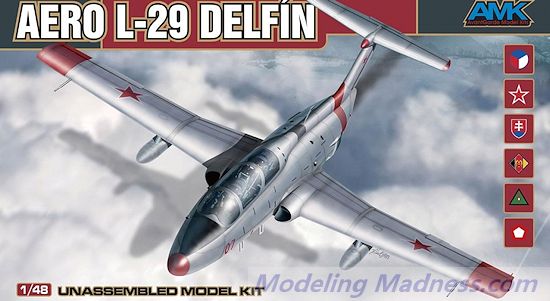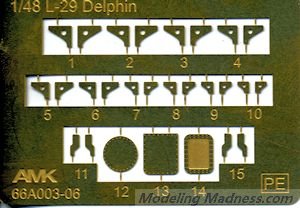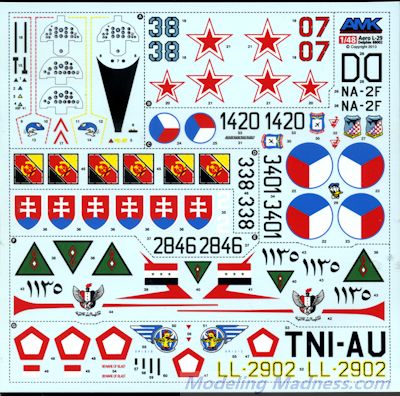
AMK 1/48 L-29 'Delfin'
| KIT #: | amk88002 |
| PRICE: | $40.95 SRP |
| DECALS: | Seven options |
| REVIEWER: | Scott Van Aken |
| NOTES: | New tool kit |

| HISTORY |
The Aero L-29 Delfín (English: Dolphin, NATO reporting name: Maya) is a military jet trainer aircraft that became the standard jet trainer for the air forces of Warsaw Pact nations in the 1960s. It was Czechoslovakia's first locally designed and built jet aircraft.
In the late 1950s, the Soviet Air Force was seeking a jet-powered replacement for its fleet of piston-engined trainers, and this requirement was soon broadened to finding a trainer aircraft that could be adopted in common by Eastern Bloc air forces. Aero's response, the prototype XL-29 designed by Z. Rublič and K. Tomá first flew on 5 April 1959, powered by a British Bristol Siddeley Viper engine. The second prototype was powered by the Czech-designed M701 engine, which was used in all subsequent aircraft.
The basic design concept was to produce a straightforward, easy-to-build and operate aircraft. Simplicity and ruggedness were stressed with manual flight controls, large flaps and the incorporation of perforated airbrakes on the fuselage sides providing stable and docile flight characteristics, leading to an enviable safety record for the type. The sturdy L-29 was able to operate from grass, sand or unprepared fields. Both student pilot and instructor had ejection seats, and were positioned in tandem, under separate canopies with a slightly raised instructor position.
In 1961, the L-29 was evaluated against the PZL TS-11 Iskra and Yakovlev Yak-30 and emerged the winner. Poland chose to pursue the development of the TS-11 Iskra anyway, but all other Warsaw Pact countries adopted the Delfin under the agreements of COMECON.
Production began April 1963 and continued for 11 years, with 3,600 eventually built until 1974. A dedicated, single-seat, aerobatic version was developed as the L-29A Akrobat. A reconnaissance version with nose-mounted cameras was built as the L-29R.
The L-29 was operated by literally dozens of air forces and is still equipping a handful. A considerable number are being operated as warbirds.
| THE KIT |
 I
am not sure with whom AMK is associated or if it is a start-up
company, but it is made in China and the company itself is based in
Macau. The molding on the kit is first rate with the now to be
expected engraved detailing and plethora of sunken rivets/screws. I
found absolutely no molding glitches, not even ejector pin marks
inside gear doors.
I
am not sure with whom AMK is associated or if it is a start-up
company, but it is made in China and the company itself is based in
Macau. The molding on the kit is first rate with the now to be
expected engraved detailing and plethora of sunken rivets/screws. I
found absolutely no molding glitches, not even ejector pin marks
inside gear doors.  The
kit includes a photo etch fret that interestingly, does not include
a set of seat harnesses. These bits are for the belly antennas,
speed brake hinges, and the detail inside the flap housings on the
wing. Clear parts are very clear and include things like
landing lights and the blast shield in between the front and rear
seats. I like that the canopy sections include the framework,
something a few new kits have done separately.
The
kit includes a photo etch fret that interestingly, does not include
a set of seat harnesses. These bits are for the belly antennas,
speed brake hinges, and the detail inside the flap housings on the
wing. Clear parts are very clear and include things like
landing lights and the blast shield in between the front and rear
seats. I like that the canopy sections include the framework,
something a few new kits have done separately.  r
wells are nicely detailed with the nose gear well being part of the
nose detail assembly. I like that for the main gear, the wheels and
tires are separate parts, making painting much easier. While the
ailerons are fixed in place, the elevator and rudder pieces are
separate. Speed brakes can be posed open or closed. You can also
pose the two canopies open or closed as you so wish. They are very
clear so any detail in the cockpit will be easily seen. Two drop
tanks are provided for under the wings. AMK has already opened the
holes for these so if you choose not to use them, you will need to
fill these holes.
r
wells are nicely detailed with the nose gear well being part of the
nose detail assembly. I like that for the main gear, the wheels and
tires are separate parts, making painting much easier. While the
ailerons are fixed in place, the elevator and rudder pieces are
separate. Speed brakes can be posed open or closed. You can also
pose the two canopies open or closed as you so wish. They are very
clear so any detail in the cockpit will be easily seen. Two drop
tanks are provided for under the wings. AMK has already opened the
holes for these so if you choose not to use them, you will need to
fill these holes. | CONCLUSIONS |
| REFERENCES |
http://en.wikipedia.org/wiki/Aero_L-29
May 2014
You can thank me for picking this one up.
If you would like your product reviewed fairly and fairly quickly, please contact the editor or see other details in the Note to Contributors.
Back to the Previews Index Page